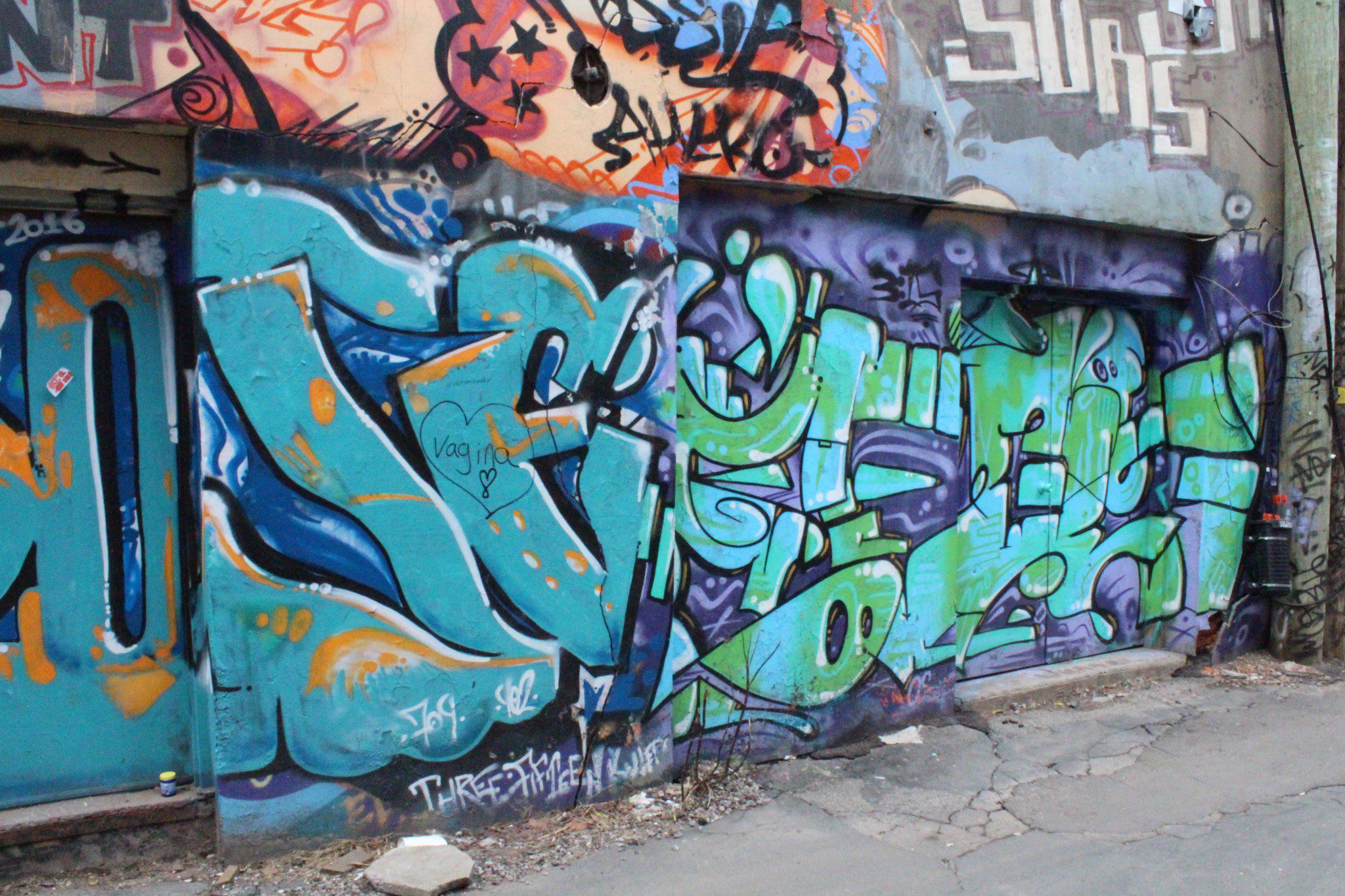In the last three years, St. Luke’s United Church on Sherbourne and Carlton streets has spent around $1,000 annually to remove graffiti.
The church even needed to buy an $800 power-washer. St. Luke’s would remove graffiti once every couple of years. Now, that happens about twice a year.
Joanne Mastrotucci is the church administrator at St. Luke’s. She began working there 15 years ago, when she says graffiti on the church was much less common. She said she has noticed a significant increase in graffiti on the building.
The church runs a food bank and a meal program, which aid members of the community. Mastrotucci says that the cost to remove graffiti takes away funding from these initiatives.
She regrets “every dollar I have to spend on what I consider wasteful expenses of money,” she said. “Removing graffiti is money that does not get spent on our meal program.”
Mastrotucci describes the current style of graffiti as larger and “more destructive.” It is also common to see tags on the sandstone façade area of the building. Graffiti on this part of the church is particularly bothersome since it is very difficult to remove without damaging the stones.
In 2011, under the late Mayor Rob Ford, Toronto passed a bill aimed at sharing the responsibility of keeping graffiti under control among residents and government. Private owners must remove graffiti on their own buildings, while the city remained responsible for cleaning vandalism on government property.
The City of Toronto’s Municipal Licensing and Standards division (ML&S) handles graffiti complaints in the same way it handles complaints of long grass, weeds, or waste on private property. First, an advisory letter of the complaint is sent to the property owner. Then, according to Scott Sullivan, director of investigation services with the Municipal Licensing and Standards Division, in seven to 10 days, a notice of violation is sent.
The graffiti bylaw gives people 72 hours from the time they receive the notice of violation to the time the city may enter their property and remove it themselves. When this is done, the city charges the cost of covering the graffiti to the property owner’s taxes.
Sullivan said that this is usually a more lenient process than the written bylaw suggests.
“Obviously we want to work with people because we understand they’ve been a victim of vandalism, but we also have the expectation that they maintain their property,” Sullivan said.
Sullivan said that seasonal factors, like freezing temperatures, elderly property owners or financial barriers can change considerations for the time given.
“As long as the people communicate with us and have a plan to deal with the graffiti that’s reasonable in our opinion, then we’re not going to go in and do the remedial work ourselves,” Sullivan said.
In instances of hate graffiti, or graffiti that intends to incite violence, the bylaw allows the city to immediately enter the property and remove it. In these cases, the city covers the cost of the work.
Kensington store-owner says by-law enforcers missing: graffiti rampant
Perola’s Supermarket in Kensington market had been well-known for its intricate red mural and its Latin American foods – though now it is only known for the latter.
The mural, painted by artist Jimmy Chiale in 2016, had become one of the characteristic artworks of Kensington. In February 2017, a massive tag was spray painted over much of the mural.
While the owner, Hector Lopez quickly commissioned a new mural to cover the tag, a Reddit post criticizing the vandal racked up over 300 likes and over 260 comments.
Lopez said he used to spend about $1,200 to have graffiti cleaned off his building three to four times per year. That was three years ago, he said, when city workers would regularly patrol the area and issue notices.
But in recent years, Lopez said he had stopped receiving notices, or seeing city workers around the area. He said this has led to an increase in graffiti across the neighbourhood.
“The street [does not] look nice. This is the problem. Kensington market is a tourist area, and it looks very bad,” Lopez said. “For me, [this] is bad for business.”
When told about vendors in Kensington Market who have noticed a decline in bylaw officers scanning the area, Sullivan said it was probable.
“From time to time there’ll be proactive approaches like with a lot of things in the city. Something will become an issue at the forefront and become a priority and then we will assign more resources to it.”
Right now, he said, the focus is on the sharing economy, a transition to creating direct transaction between goods or services and buyers.
Graffiti is still a priority, he said, however it has shifted to a priority within the public realm. ML&S focus on graffiti that is visible from areas most commonly used by the public. But Sullivan said that the late mayor Rob Ford’s term in office had little to do with these changes.
“If you even go back prior to that when, you know, I think it was back in 2005 when David Miller was mayor, he had his clean and beautiful city initiative,” he said. “From time to time there will be identified priorities by council and then resources are allocated accordingly.”
A dance with data
The figures were released only after the Toronto Observer found that ML&S, which handles and enforces all of the city’s by-laws and publishes updated spreadsheets regularly, was publishing only partial graffiti records on the municipality’s Open Data website. These updated numbers are still not on the website.
The Open Data records report “Investigation Activity” of all of the department’s by-law enforcement complaints, including graffiti, with “details of all active investigation matters”, such as location and status of the investigation. The data details cases of infractions covering everything from inadequate heating in rental properties to noise and long grass complaints.
The data from the Open Data site, retrieved in February 2017, said that there were only 3,050 complaints filed between 2008 and 2016 —almost all were in 2015 and 2016. There were hardly any reported during the Ford administration, but a flood seem to have been reported under Mayor John Tory.
Tammy Robbinson, the spokesperson for MLS, explained that the discrepancy in the data came about because the city’s original data file only contained open cases. The new data accounts for both open and closed cases.

Chart by Toronto Municipal Licensing and Standards Division
While the city’s records may be incomplete, private property owners have plenty of stories about the kinds of graffiti they are seeing. There are particular patterns and familiar graffiti tags, which Joanne Mastrotucci, at St. Luke’s, now recognizes. Some of these familiar tags can be seen on different buildings around the area.
“The person that was hitting the front of the church hit a lot of frontages up and down Sherbourne over several months,” Mastrotucci said.
Across Toronto, there have been incidents as recently as 2015 that seem to fit this description. According to the original information provided by Municipal Licensing and Standards, 114 incidents of graffiti and notice-issued graffiti were recorded on Dec. 17, 2015. With the exception of two outliers, the incidents were contained to one block: a subdivision off Lansdowne Avenue, just south of Bloor Street.
In the same year, on June 1, 2015 there were 90 recorded incidents of graffiti and notice-issued graffiti. This time, with the exception of nine outliers, the reports were contained to Danforth Avenue, between Main Street and Victoria Park Avenue.
Two years later, it’s impossible to tell exactly which tags on Danforth Avenue were from this mass incident; there still are so many that have not been removed. There is evidence, however, of multiple attempts to simply cover-up these tags with stickers. The gallery below shows a few examples of graffiti that Toronto Observer found on a recent site visit.
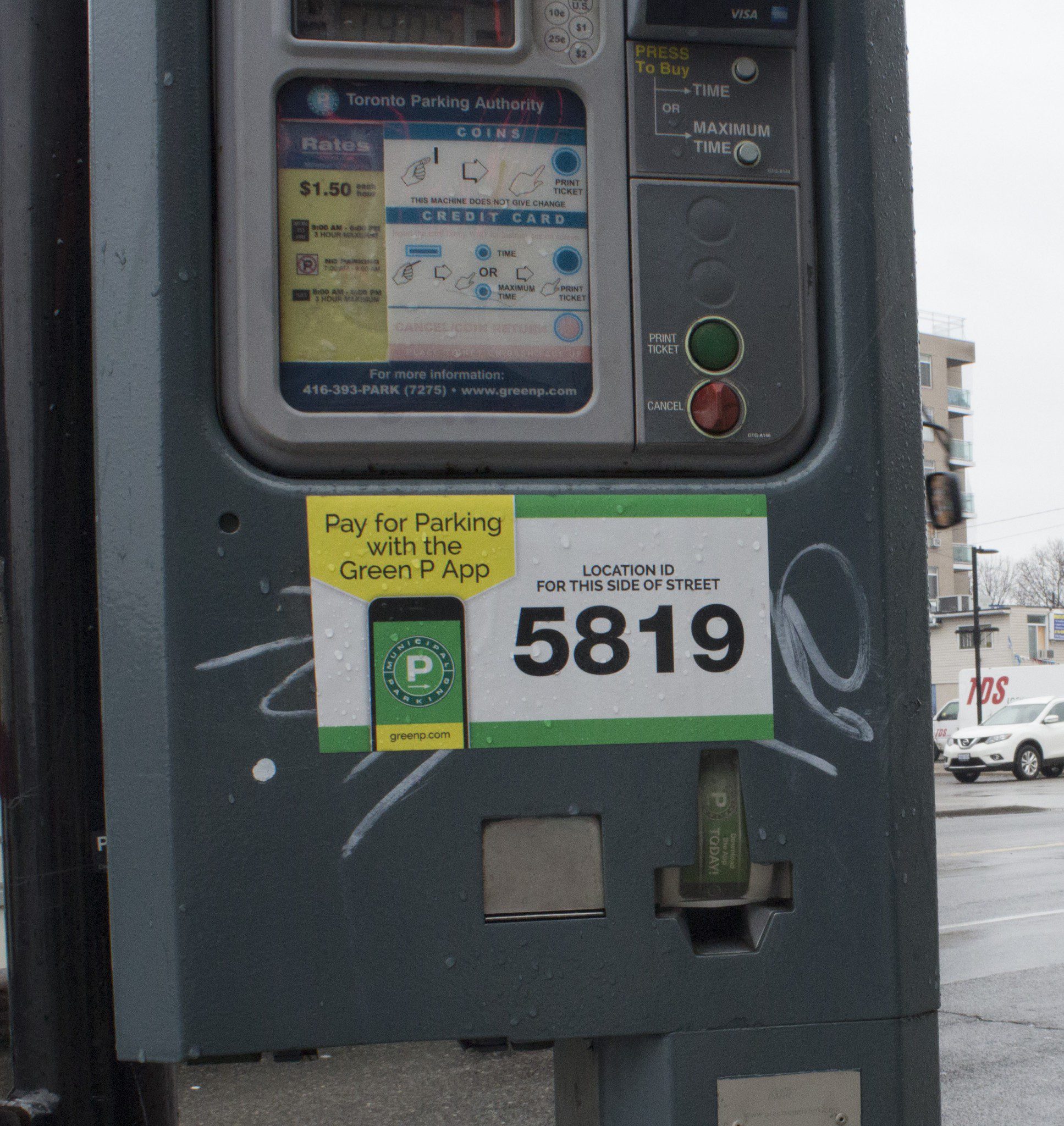
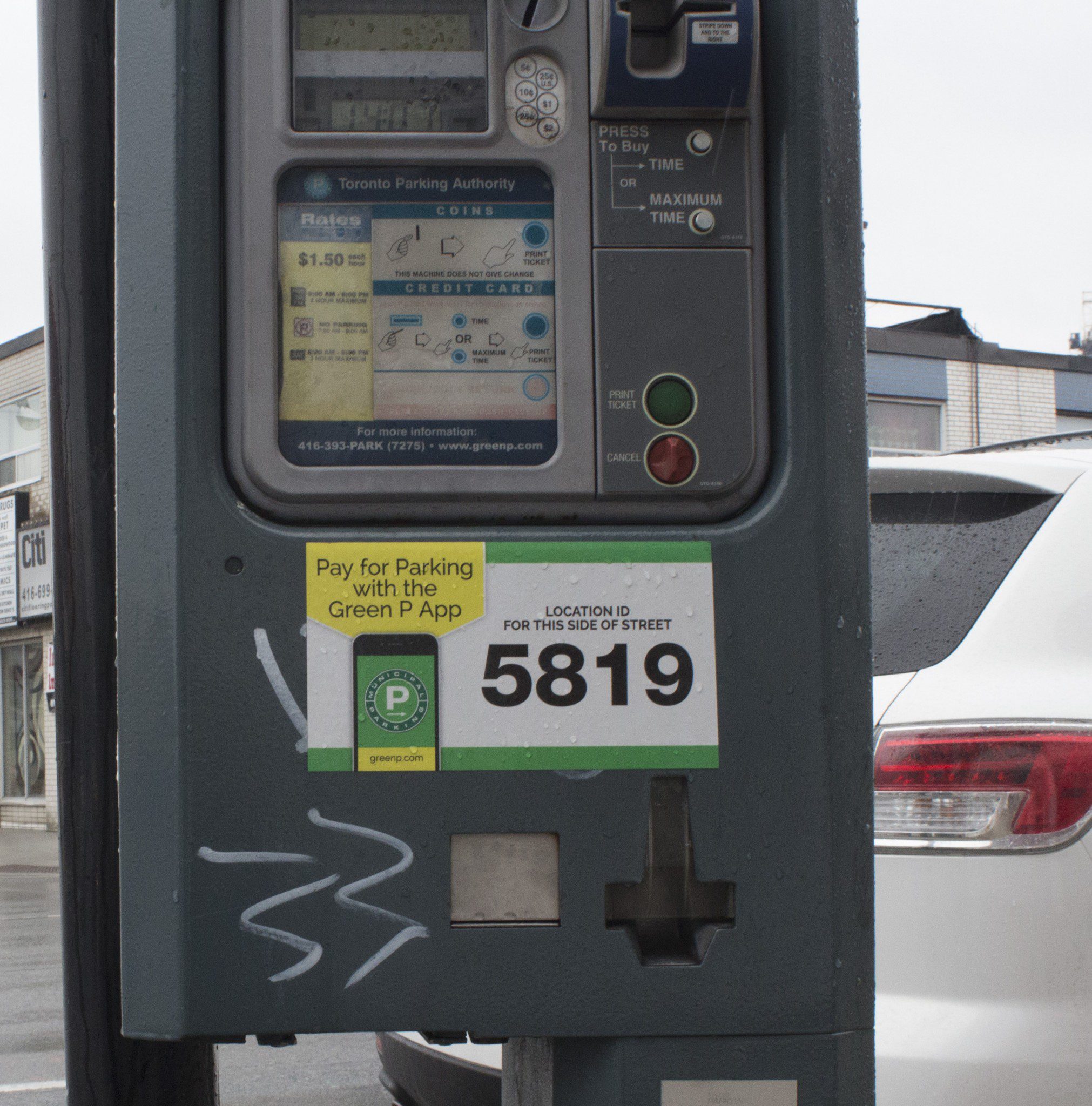
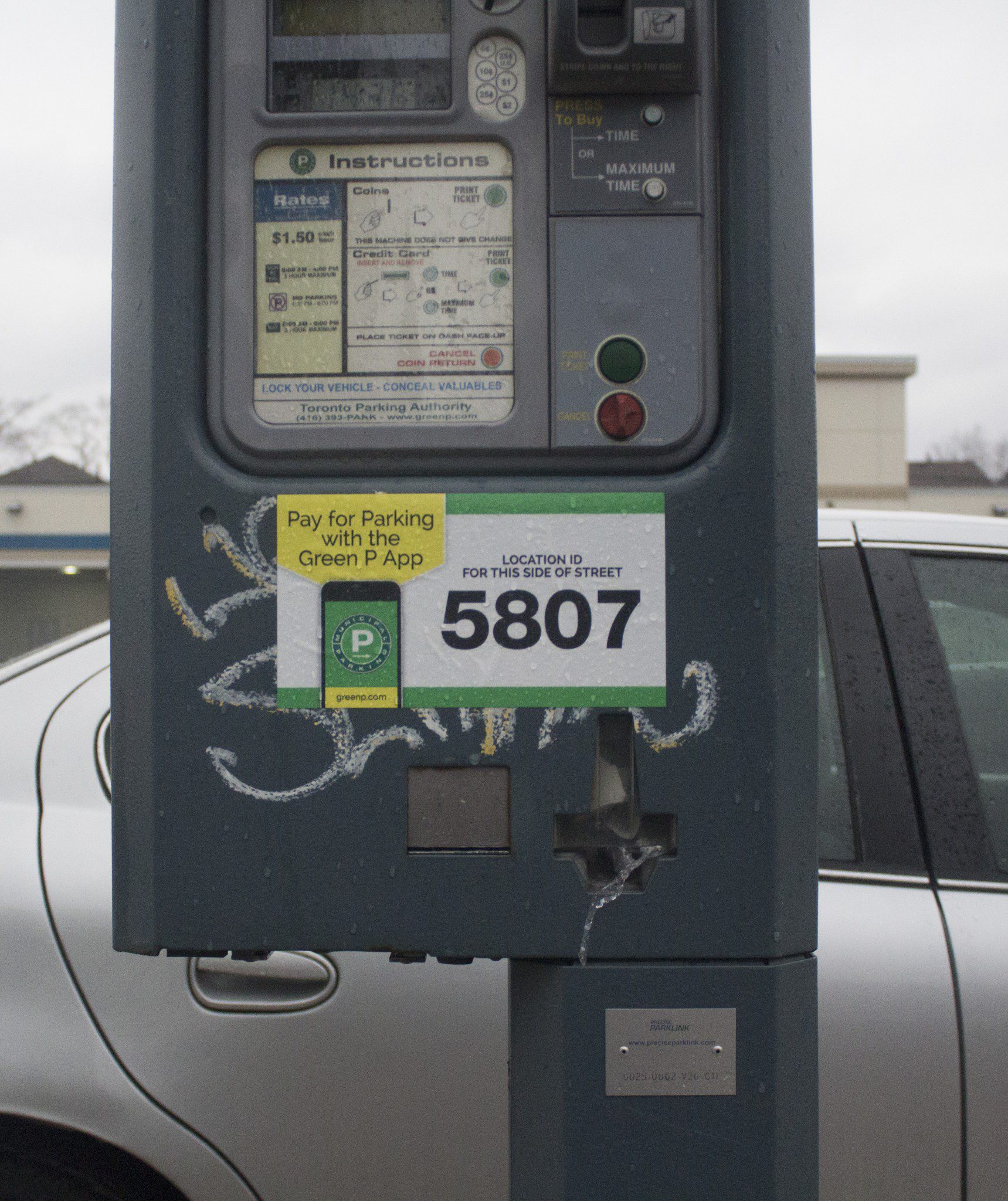
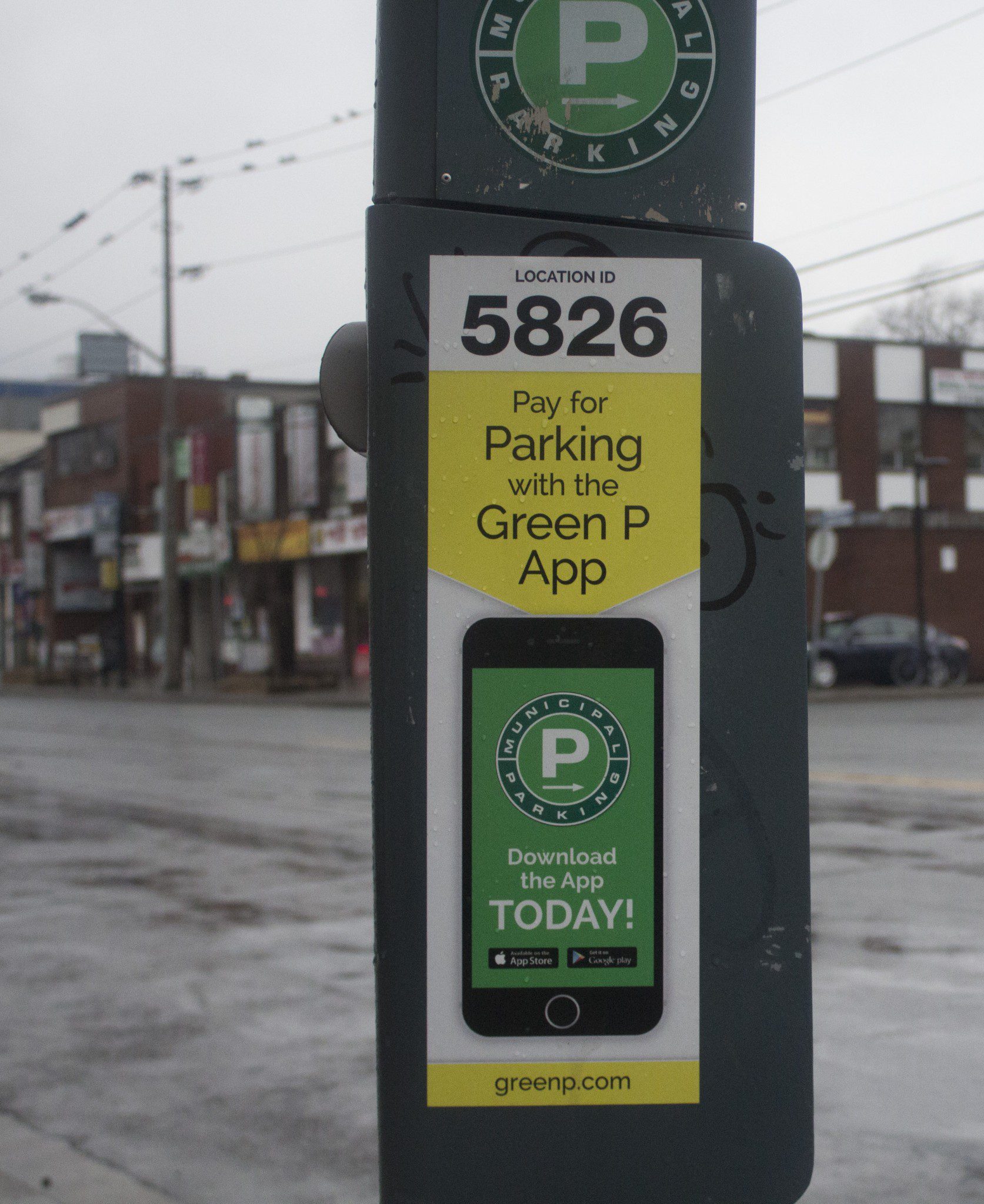
Stickers are a repeated method of dealing with graffiti on parking meters along Danforth Avenue.
Sullivan said that cleaning parking meters is not the responsibility of ML&S; rather this falls under the Transportation department’s office of the Public Realm/Beautiful Streets initiative, which deals with all street furnishings. They are, however, supposed to follow-up and ensure the graffiti is properly removed.
“Putting a sticker on would not be an acceptable means of removing (graffiti) on a permanent structure,” Sullivan said.
He added that a sticker would probably be in contravention of a property standards bylaw for many structures, though it is not the case for parking meters. Sullivan said in some instances, things like construction warning posters of work ahead may be considered a temporary solution for graffiti, but the vandalism must be completely covered.
The city government does not do enforcement on its own property, but it does hold itself to the same standards applied to private property owners.
Enlarge

Olivia Blackmore/Toronto Observer
“We can’t afFORD this”
At one point it was the most viewed mural in the city, Javid Jah said.
Jah, who is an architect, is the artist behind the famous “We can’t afFORD this” mural in Kensington Market.
“I had a Japanese tour bus stop in front of my house at 9 in the morning while I’m drinking my coffee, and empty out a whole group of people,” Jah recalled.
Jah, who’s been a street artist since the early 2000s, has noticed the way the city has changed its approach when it comes to programs to address graffiti vandalism. Before Rob Ford, Graffiti Transformation was a program created in the late ’90s which partnered youth with street art mentors to replace vandalism with commissioned murals.
“That was devised by youth empowerment really and to couple it up with the fact to clean up some walls, so-called vandal walls,” Jah said. He joined the program in 2002.
When Ford came into office in 2010, things changed with his infamous “war on graffiti.”
“I guess Rob Ford used graffiti as a way to kind of channel his platform to hit on an issue that was volatile, and make it something important and I don’t really think it’s that big of a deal,” Jah said.
By 2011 the city had modified its graffiti bylaw and adapted a stricter protocol when it came to handling graffiti complaints. Property owners who were being issued notices could either remove the graffiti themselves, or pay the city to remove it for them. In many cases the “graffiti” that drove the complaint was actually a commissioned street art mural that the property owner had paid for.
“That’s when the can of worms really opened up,” Jah said. “Who really has a say on what goes on public walls, when owned by a private property owner? Why is the city coming in, it’s private space.”
In 2012 the city launched its StART program to address this issue and help create more awareness of street art. It focused on creating a directory of artists on the city’s website that could be commissioned for murals. This helped regularize street art and avoid conflicts with Municipal Licensing and Standards, and deter vandalism.
“I think their [StART] heart is in the right place,” Jah said. “At the end of the day there’s going to be a portion of artists that remain anonymous and there’s always going to be vandalism in urban areas so it’s a good starting point.”
The war on graffiti
For years, Toronto has had a complicated relationship with graffiti. In 2011, the late Rob Ford waged a war. The former mayor disliked graffiti so much, that he would power-wash the spray paint off walls himself. Joe Magalhaes remembers driving along the Gardiner Expressway with Ford, and the former mayor would point out every single piece of graffiti he saw.
Magalhaes is a district manager of investigation services for the Municipal Licensing and Standards department. When a mural or piece is subject to a complaint, ML&S will investigate first before issuing a notice to have the graffiti removed. They decide on the spot whether it’s art or vandalism.
Property owners who are issued a notice but feel as though the rendering is art can take their case to the city. They can appeal to the city’s Graffiti Panel, which ultimately decides whether the graffiti can be considered as art. It is composed of three to four city staff from different divisions such as Heritage Preservation Services and City Planning. Meetings of the Graffiti Panel have quickly petered out since Ford left office. The panel met three times in 2012 and five times in 2013. In 2014, they met five times before a June meeting was canceled. Not enough members of the panel attended. They had one more meeting, and the final scheduled meeting of the year was cancelled. In 2015 they met only once. In 2016, their only scheduled meeting was cancelled. The panel has five meetings scheduled for 2017, starting in April.
“Those folks [the Graffiti Panel] are city staff who consider the matter before them, consider the information provided by both city staff, as well as the person who’s requesting the exemption as an art mural,” Magalhaes said.
Members of the community, as well as the artist who created the piece, are also encouraged to attend the appeal, says Magalhaes.
“Beautiful now means there’s street art,” Magalhaes said. “I think that’s why the panel hasn’t met for a while because we have the ability to look at it under a different lens.”
Because of this new awareness on the city’s part, ML&S has been able to identify the differences between vandalism and street art, whereas three to four years ago, everything was considered vandalism. This could explain the decline in numbers of recorded complaints.
“What I’m finding is through different campaigns there’s more awareness as what constitutes as graffiti and what constitutes as street art,” Magalhaes said. “You’re finding a change in the culture.”
Enter Const. Jon Morrice of Toronto police 55 Division. Morrice is currently in the final stages of an initiative called “Paint that Laneway.” Working closely with an organization called The Laneway Project, the project will commission graffiti artists to paint attractive murals and graffiti art to deter illegal and unsightly tags.
The project is set to launch this spring and will be confined to 55 Division, which is located between the Don Valley Parkway and Victoria Park Avenue, south of the Danforth. Should Paint that Laneway be successful, Morrice hopes to bring similar initiatives to other police divisions.
Although his area is a suburban area, and Coun. Mike Ford does not receive many calls from his residents to have illegal graffiti cleaned up, the nephew of the late mayor does support what his uncle was trying to do to manage the city’s urban space.
“A city that is neutral for everyone to live in was very important to him,” said Ford, now a city councillor for Ward 2 Etobicoke North.
The younger Ford also now receives requests for artists who want to showcase their work.
“I think there’s different types of graffiti, and art work,” he said. “When we talk about illegal graffiti per se, I think that you need to respect people’s property.”
The commissioned mural on an overpass on Kipling Avenue?
“It’s a beautiful piece of artwork, and that added to the community,” Ford said.

